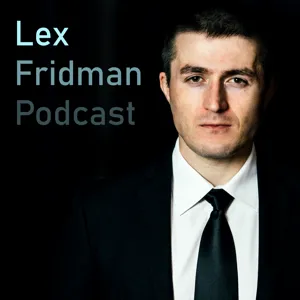Competition makes for better chip design with AMD CTO Mark Papermaster

Explore "moore's law" with insightful episodes like "Competition makes for better chip design with AMD CTO Mark Papermaster", "Best Of: The Most Amazing — and Dangerous — Technology in the World", "The Most Amazing — and Dangerous — Technology in the World", "#104 – David Patterson: Computer Architecture and Data Storage" and "How 5G and edge computing fit into the future of Intel’s traditionally chip-focused lineup" from podcasts like ""No Priors: Artificial Intelligence | Machine Learning | Technology | Startups", "The Ezra Klein Show", "The Ezra Klein Show", "Lex Fridman Podcast" and "The Vergecast"" and more!


“We rarely think about chips, yet they’ve created the modern world,” writes the historian Chris Miller.
He’s not exaggerating. Semiconductors power everything from our phones and computers to cars, planes, advanced military equipment, and A.I. systems. Chips are the foundation of modern economic prosperity, military strength and geopolitical power.
This conversation with Chris Miller, author of “Chip War: The Fight for the World’s Most Critical Technology,” was recorded back in April. But we wanted to re-air it, because what Miller lays out in that book, and in this conversation, is essential to understanding where we are in 2023, and the faultlines that will shape the world ahead.
Because semiconductors have one of the most concentrated supply chains of any technology today. One Taiwanese company, TSMC, produces around 90 percent of the most advanced chips. A single Dutch firm, ASML, produces all of the world’s EUV lithography machines, which are essential to produce leading-edge chips. The entire industry is built like this.
That doesn’t just make the chip supply chain vulnerable to external shocks; it also makes it easily weaponizable by the powers that control it. In 2022, the Biden administration banned exports of advanced chips — and the equipment needed to produce those chips — to China, and then further tightened those rules this October. In August 2022, President Biden signed into law the bipartisan CHIPS and Science Act, which includes a $52 billion investment to on-shore U.S. chip manufacturing. China has invested tens of billions of dollars over the past decade to build a domestic semiconductor industry of its own. Chips have become to the geopolitics of the 21st century what oil was to the geopolitics of the 20th.
In this conversation, Miller talks me through what semiconductors are, why they matter and how they are shaping everything from U.S.-China relations and the Russia-Ukraine war to the Biden policy agenda and the future of A.I.
Mentioned:
“The Problem With Everything-Bagel Liberalism” by Ezra Klein
Book Recommendations:
The World For Sale by Javier Blas and Jack Farchy
Nexus by Jonathan Reed Winkler
Prestige, Manipulation and Coercion by Joseph Torigian
Thoughts? Guest suggestions? Email us at ezrakleinshow@nytimes.com.
You can find transcripts (posted midday) and more episodes of “The Ezra Klein Show” at nytimes.com/ezra-klein-podcast, and you can find Ezra on Twitter @ezraklein. Book recommendations from all our guests are listed at https://www.nytimes.com/article/ezra-klein-show-book-recs.
“The Ezra Klein Show” is produced by Annie Galvin, Emefa Agawu, Jeff Geld, Rogé Karma and Kristin Lin. Fact-checking by Michelle Harris. Mixing by Jeff Geld. Original music by Isaac Jones. Audience strategy by Shannon Busta. The executive producer of New York Times Opinion Audio is Annie-Rose Strasser. Special thanks to Pat McCusker and Kristina Samulewski.

“We rarely think about chips, yet they’ve created the modern world,” writes the historian Chris Miller.
He’s not exaggerating. Semiconductors don’t just power our phones and computers; they also enable our cars, planes and home appliances to function. They are essential to everything from developing advanced military equipment to training artificial intelligence systems. Chips are the foundation of modern economic prosperity, military strength and geopolitical power.
But semiconductors are also part of one of the most concentrated supply chains of any technology today. One Taiwanese company, TSMC, produces 90 percent of the most advanced chips. A single Dutch firm, ASML, produces all of the world’s EUV lithography machines, which are essential to produce leading-edge chips. The entire industry is built like this.
That doesn’t just make the chip supply chain vulnerable to external shocks; it also makes it easily weaponizable by the powers that control it. In October, the Biden administration banned exports of advanced chips — and the equipment needed to produce those chips — to China. In August, President Biden signed into law the bipartisan CHIPS and Science Act, which includes a $52 billion investment to on-shore U.S. chip manufacturing. China has invested tens of billions of dollars over the past decade to build a domestic semiconductor industry of its own. Chips have become to the geopolitics of the 21st century what oil was to the geopolitics of the 20th.
There is no better or more timely explanation of the semiconductor industry — and the geopolitics that have formed around them — than Miller’s new book, “Chip War: The Fight for the World’s Most Critical Technology.” So I asked him on the show to talk me through what semiconductors are, why they matter and how they are shaping everything from U.S.-China relations and the Russia-Ukraine war to the Biden policy agenda and the future of A.I.
Mentioned:
“The Problem With Everything-Bagel Liberalism” by Ezra Klein
Book Recommendations:
The World For Sale by Javier Blas and Jack Farchy
Nexus by Jonathan Reed Winkler
Prestige, Manipulation and Coercion by Joseph Torigian
Thoughts? Guest suggestions? Email us at ezrakleinshow@nytimes.com.
You can find transcripts (posted midday) and more episodes of “The Ezra Klein Show” at nytimes.com/ezra-klein-podcast, and you can find Ezra on Twitter @ezraklein. Book recommendations from all our guests are listed at https://www.nytimes.com/article/ezra-klein-show-book-recs.
“The Ezra Klein Show” is produced by Annie Galvin, Emefa Agawu, Jeff Geld, Rogé Karma and Kristin Lin. Fact-checking by Michelle Harris. Mixing by Jeff Geld. Original music by Isaac Jones. Audience strategy by Shannon Busta. The executive producer of New York Times Opinion Audio is Annie-Rose Strasser. Special thanks to Pat McCusker and Kristina Samulewski.


Stay up to date
For any inquiries, please email us at hello@podcastworld.io